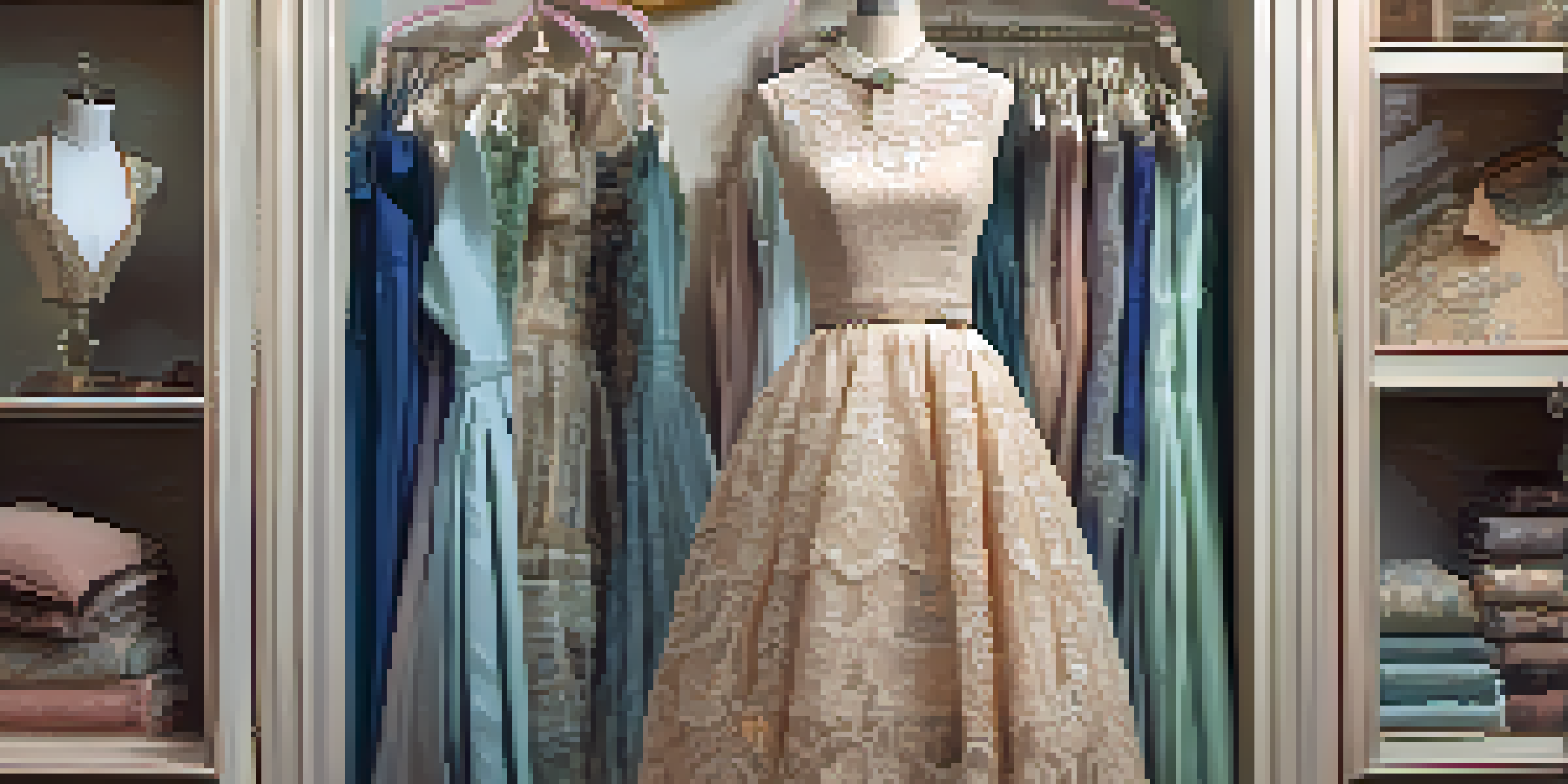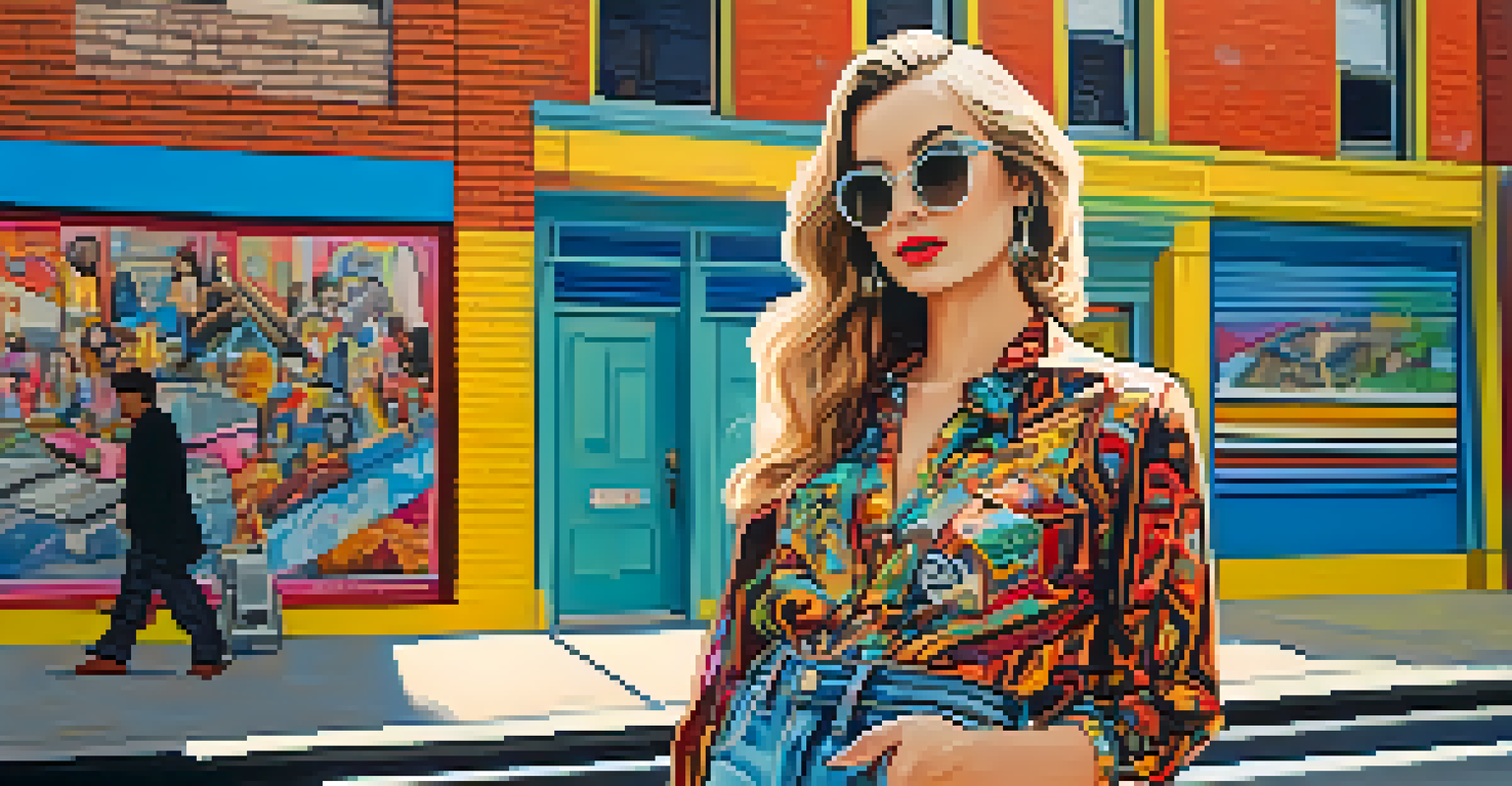The Revival of Vintage Art in Contemporary Fashion Choices

Understanding Vintage Art and Its Allure in Fashion
Vintage art refers to artwork created in earlier decades, often showcasing unique styles and cultural narratives. Its allure lies in the nostalgia it evokes, reminding us of past eras filled with creativity and expression. In fashion, this nostalgia taps into our desire for individuality and authenticity, making vintage-inspired pieces highly sought after.
Fashion is the armor to survive the reality of everyday life.
In contemporary fashion, vintage art is not just a trend; it’s a movement that celebrates craftsmanship and storytelling through clothing. Designers often draw inspiration from iconic art movements, such as Art Deco or Surrealism, incorporating those elements into modern designs. This blending of old and new creates a fresh aesthetic that resonates with fashion enthusiasts.
Moreover, the revival of vintage art in fashion encourages sustainable practices. By embracing vintage styles, we reduce waste and promote the idea of reusing and repurposing clothing. This commitment to sustainability is becoming increasingly important in today’s fashion landscape.
The Role of Iconic Designers in Reviving Vintage Art
Iconic designers play a pivotal role in reviving vintage art by infusing their collections with historical references. Brands like Gucci and Balenciaga frequently draw upon past eras, creating pieces that reflect vintage art styles while appealing to the modern consumer. This fusion allows consumers to appreciate the artistry of the past in a contemporary context.

For example, Alessandro Michele's work at Gucci has been celebrated for its eclectic mix of vintage patterns and bold colors, reminiscent of the 70s. Such designs invite wearers to express their individuality while paying homage to artistic movements that shaped fashion history. This connection to the past enriches the overall fashion narrative.
Vintage Art Fuels Fashion Trends
Vintage art inspires contemporary fashion by blending historical styles with modern aesthetics, promoting individuality and creativity.
Ultimately, these designers not only celebrate vintage art but also inspire a new generation of creatives to explore and reinterpret these styles. Their influence helps to keep vintage art alive, ensuring it continues to evolve alongside modern fashion trends.
Vintage Art Movements Shaping Today's Fashion Trends
Several vintage art movements significantly influence today's fashion trends. The Pop Art movement, for example, has led to vibrant prints and graphic designs that are prevalent in many collections. Designers often incorporate bold colors and playful imagery, evoking the spirit of artists like Andy Warhol.
The best part of vintage is that every piece has a story, and when you wear it, you become part of that story.
Another influential movement is Art Nouveau, characterized by its flowing lines and organic forms. Many contemporary designers use these elements to create intricate patterns and designs that add a touch of elegance to modern attire. This blend of art and fashion speaks to a diverse audience, appealing to those who appreciate both aesthetics.
By drawing on these vintage art movements, fashion brands are able to create unique pieces that stand out in a crowded market. This strategy not only attracts art enthusiasts but also encourages consumers to explore the rich history behind their clothing choices.
Consumer Trends: A Shift Towards Vintage Fashion Choices
Recent consumer trends indicate a significant shift towards vintage fashion choices. More people are seeking unique pieces that tell a story rather than opting for mass-produced items. This desire for individuality is driving the popularity of thrift shopping and vintage boutiques.
Social media platforms, especially Instagram and TikTok, have amplified this trend by showcasing vintage fashion styles. Influencers and fashion enthusiasts share their unique finds, inspiring others to embrace vintage aesthetics. This community-driven approach to fashion fosters a sense of belonging among those who appreciate the beauty of vintage art.
Sustainability in Vintage Fashion
The revival of vintage fashion encourages sustainable practices, as consumers increasingly prioritize unique pieces that reduce waste and environmental impact.
As consumers become more conscious of their fashion choices, the demand for vintage-inspired pieces continues to grow. This trend reflects a broader cultural shift towards valuing authenticity and sustainability in fashion, encouraging brands to adapt and innovate.
The Impact of Technology on Vintage Fashion Revival
Technology has dramatically impacted the revival of vintage fashion, making it easier for consumers to access unique pieces. Online platforms and marketplaces have emerged, allowing vintage lovers to shop from the comfort of their homes. This convenience has fueled interest in vintage art and fashion.
Moreover, advancements in digital design tools enable designers to recreate vintage styles more accurately. This technology allows for the exploration of intricate patterns and textures that were once challenging to replicate. As a result, contemporary fashion can pay homage to vintage art while maintaining high-quality craftsmanship.
Additionally, social media plays a crucial role in promoting vintage fashion. Designers and consumers share their vintage-inspired looks online, creating a vibrant community that celebrates this revival. The interplay between technology and fashion not only enhances accessibility but also fosters creativity and collaboration.
Sustainable Fashion: The Vintage Art Connection
The connection between vintage art and sustainable fashion is becoming increasingly evident. As the fashion industry grapples with sustainability challenges, vintage pieces offer a viable solution. By reusing and repurposing clothing, we can minimize waste and reduce our environmental impact.
Many consumers are now prioritizing sustainable choices, leading to a renewed interest in vintage shopping. Thrifting not only provides access to unique styles but also promotes a more eco-friendly approach to fashion. This shift encourages individuals to rethink their shopping habits and embrace the beauty of vintage art.
Community and Individuality in Vintage
Vintage fashion fosters a sense of community and self-expression, allowing individuals to connect over shared interests while celebrating their unique style.
Furthermore, designers are recognizing the importance of sustainability in their collections. By incorporating vintage elements, they can create timeless pieces that transcend seasonal trends. This commitment to sustainability not only benefits the environment but also enriches the narrative of contemporary fashion.
Celebrating Individuality Through Vintage Fashion Choices
One of the most delightful aspects of vintage fashion is its ability to celebrate individuality. Each vintage piece comes with its own story, allowing wearers to express their unique style. This personal connection to clothing fosters a sense of pride and authenticity.
Wearing vintage art-inspired fashion pieces can spark conversations and connections among people with similar interests. It's not just about clothing; it's about embracing a shared appreciation for art and history. This sense of community adds a layer of depth to the vintage fashion experience.

As more individuals explore their personal style through vintage choices, the fashion landscape continues to evolve. This celebration of individuality encourages creativity and self-expression, making vintage fashion a vibrant and dynamic part of contemporary culture.